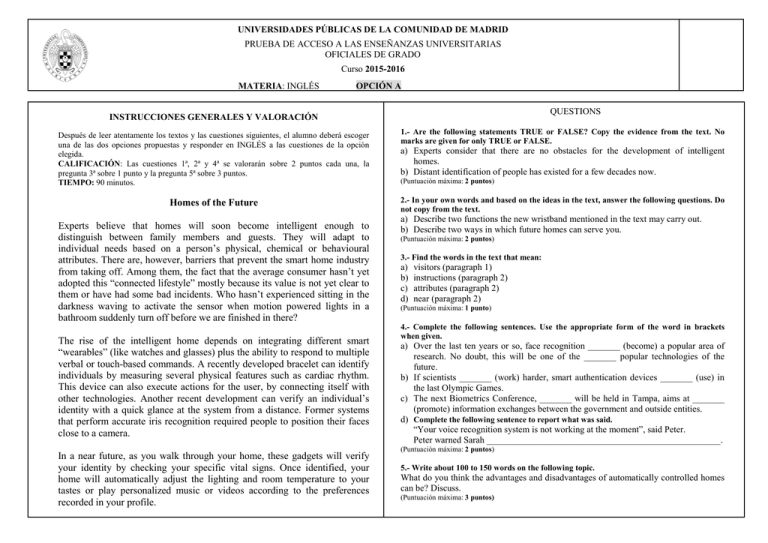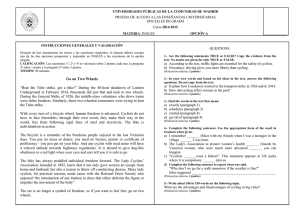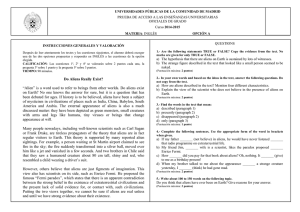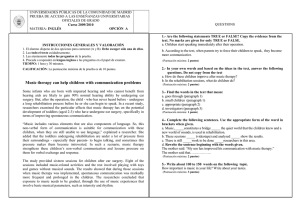Homes of the Future Experts believe that homes will soon become
Anuncio

UNIVERSIDADES PÚBLICAS DE LA COMUNIDAD DE MADRID PRUEBA DE ACCESO A LAS ENSEÑANZAS UNIVERSITARIAS OFICIALES DE GRADO Curso 2015-2016 MATERIA: INGLÉS OPCIÓN A QUESTIONS INSTRUCCIONES GENERALES Y VALORACIÓN 1.- Are the following statements TRUE or FALSE? Copy the evidence from the text. No marks are given for only TRUE or FALSE. Después de leer atentamente los textos y las cuestiones siguientes, el alumno deberá escoger una de las dos opciones propuestas y responder en INGLÉS a las cuestiones de la opción elegida. CALIFICACIÓN: Las cuestiones 1ª, 2ª y 4ª se valorarán sobre 2 puntos cada una, la pregunta 3ª sobre 1 punto y la pregunta 5ª sobre 3 puntos. TIEMPO: 90 minutos. a) Experts consider that there are no obstacles for the development of intelligent homes. b) Distant identification of people has existed for a few decades now. Homes of the Future 2.- In your own words and based on the ideas in the text, answer the following questions. Do not copy from the text. Experts believe that homes will soon become intelligent enough to distinguish between family members and guests. They will adapt to individual needs based on a person’s physical, chemical or behavioural attributes. There are, however, barriers that prevent the smart home industry from taking off. Among them, the fact that the average consumer hasn’t yet adopted this “connected lifestyle” mostly because its value is not yet clear to them or have had some bad incidents. Who hasn’t experienced sitting in the darkness waving to activate the sensor when motion powered lights in a bathroom suddenly turn off before we are finished in there? The rise of the intelligent home depends on integrating different smart “wearables” (like watches and glasses) plus the ability to respond to multiple verbal or touch-based commands. A recently developed bracelet can identify individuals by measuring several physical features such as cardiac rhythm. This device can also execute actions for the user, by connecting itself with other technologies. Another recent development can verify an individual’s identity with a quick glance at the system from a distance. Former systems that perform accurate iris recognition required people to position their faces close to a camera. In a near future, as you walk through your home, these gadgets will verify your identity by checking your specific vital signs. Once identified, your home will automatically adjust the lighting and room temperature to your tastes or play personalized music or videos according to the preferences recorded in your profile. (Puntuación máxima: 2 puntos) a) Describe two functions the new wristband mentioned in the text may carry out. b) Describe two ways in which future homes can serve you. (Puntuación máxima: 2 puntos) 3.- Find the words in the text that mean: a) b) c) d) visitors (paragraph 1) instructions (paragraph 2) attributes (paragraph 2) near (paragraph 2) (Puntuación máxima: 1 punto) 4.- Complete the following sentences. Use the appropriate form of the word in brackets when given. a) Over the last ten years or so, face recognition _______ (become) a popular area of research. No doubt, this will be one of the _______ popular technologies of the future. b) If scientists _______ (work) harder, smart authentication devices _______ (use) in the last Olympic Games. c) The next Biometrics Conference, _______ will be held in Tampa, aims at _______ (promote) information exchanges between the government and outside entities. d) Complete the following sentence to report what was said. “Your voice recognition system is not working at the moment”, said Peter. Peter warned Sarah ______________________________________________________. (Puntuación máxima: 2 puntos) 5.- Write about 100 to 150 words on the following topic. What do you think the advantages and disadvantages of automatically controlled homes can be? Discuss. (Puntuación máxima: 3 puntos) UNIVERSIDADES PÚBLICAS DE LA COMUNIDAD DE MADRID PRUEBAS DE ACCESO A LAS ENSEÑANZAS UNIVERSITARIAS OFICIALES DE GRADO Curso 2015-2016 MATERIA: INGLÉS OPCIÓN B INSTRUCCIONES GENERALES Y VALORACIÓN Después de leer atentamente los textos y las cuestiones siguientes, el alumno deberá escoger una de las dos opciones propuestas y responder en INGLÉS a las cuestiones de la opción elegida. CALIFICACIÓN: Las cuestiones 1ª, 2ª y 4ª se valorarán sobre 2 puntos cada una, la pregunta 3ª sobre 1 punto y la pregunta 5ª sobre 3 puntos. TIEMPO: 90 minutos. Has Creativity Disappeared in Schools? Is it a coincidence that most children love writing stories and enjoy getting messy, painting, making music, inventing characters or acting out plays? At the beginning of the 20th century, Picasso said that all children are born artists and the problem is to remain an artist as we grow up. Eight years ago Ken Robinson, an expert on creativity and education, made a speech that revolutionized this topic. He firmly believes that the two concepts don’t seem to co-exist. In this speech, he argues eloquently and passionately that education is destroying our children’s capacity to think outside the box. Robinson claims that society also has a very limited definition of intelligence. This definition looks to numeracy and literacy only, and stigmatizes as “not very bright” those children who cannot read and write fluently but may excel at other subjects. But is that fair or true? His opinions are not an attack on teachers or schools, but refer instead to the whole system of education, which he says to be too linear. According to Robinson, our education system places so much emphasis on the academic subjects that any natural gift for art, music or acting is often brushed aside as we get older. He considers that creativity is as important in education as literacy; that is why he suggests we should treat it with the same status. He claims that the existing hierarchy of subjects should be eliminated. The arts, sciences, humanities, languages, physical education and maths all have equal and central contributions to a student’s education. QUESTIONS 1.- Are the following statements TRUE or FALSE? Copy the evidence from the text. No marks are given for only TRUE or FALSE. a) Robinson was the first person to claim that artistic capacities are often lost when we become adults. b) Robinson’s ideas were introduced at the end of the 20th century. (Puntuación máxima: 2 puntos) 2.- In your own words and based on the ideas in the text, answer the following questions. Do not copy from the text. a) What kind of children does society marginalize and why? b) According to Robinson, what can be done at school to improve our children’s capacities? (Puntuación máxima: 2 puntos) 3.- Find the words in the text that mean: a) b) c) d) performing (paragraph 1) puts (paragraph 2) talent (paragraph 2) wiped out (paragraph 3) (Puntuación máxima: 1 punto) 4.- Complete the following sentences. Use the appropriate form of the word in brackets when given. a) The lack of interest _______ (show) by scholars is sometimes the result of the boredom that our educational system often _______ (produce). b) If pupils’ artistic skills _______ (encourage) when they were at school, they _______ (not be) so frustrated in their adult lives. c) The _______ you study, the better marks you will get _______ school. d) Complete the following sentence to report what was said. The teacher said to me: “Don’t worry now. You’ll understand it tomorrow.” The teacher told me ________________________________________________. (Puntuación máxima: 2 puntos) 5.- Write about 100 to 150 words on the following topic. How would you promote creativity in schools? (Puntuación máxima: 3 puntos) INGLÉS CRITERIOS ESPECÍFICOS DE CORRECCIÓN El ejercicio incluirá cinco preguntas, pudiendo obtenerse por la suma de todas ellas una puntuación máxima de 10 puntos. Junto a cada pregunta se especifica la puntuación máxima otorgada. La valoración y los objetivos de cada una de estas preguntas son los siguientes: Pregunta 1: Hasta 2 puntos. Se trata de medir exclusivamente la comprensión lectora. El estudiante deberá decidir si dos frases que se le presentan son verdaderas o falsas, copiando a continuación únicamente el fragmento del texto que justifica su elección. Se otorgará 1 punto por cada apartado. Se calificará con 0 puntos la opción elegida que no vaya justificada. Pregunta 2: Hasta 2 puntos. Se pretende comprobar dos destrezas: la comprensión lectora y la expresión escrita, mediante la formulación de dos preguntas abiertas que el estudiante deberá contestar basándose en la información del texto, pero utilizando sus propias palabras en la respuesta. Cada una de las preguntas valdrá 1 punto, asignándose 0,5 puntos a la comprensión de la pregunta y del texto, y 0,5 a la corrección gramatical y ortográfica de la respuesta. Pregunta 3: Hasta 1 punto. Esta pregunta trata de medir el dominio del vocabulario en el aspecto de la comprensión. El estudiante demostrará esta capacidad localizando en el párrafo que se le indica un sinónimo, adecuado al contexto, de cuatro palabras o definiciones. Se adjudicará 0,25 por cada apartado. Pregunta 4: Hasta 2 puntos. Con esta pregunta se pretende comprobar los conocimientos gramaticales del estudiante, en sus aspectos morfológicos y/o sintácticos. Se presentarán oraciones con huecos que el estudiante deberá completar o rellenar. También podrán presentarse oraciones para ser transformadas u otro tipo de ítem. Se adjudicará 0,25 a cada “hueco en blanco” y en el caso de las transformaciones o ítems de otro tipo se concederá 0,5 con carácter unitario. Pregunta 5: Hasta 3 puntos. Se trata de una redacción, de 100 a 150 palabras, en la que el estudiante podrá demostrar su capacidad para expresarse libremente en inglés. Se propondrá una única opción y se otorgarán 1,5 puntos por el buen dominio de la lengua – léxico, estructura sintáctica, etc. – y 1,5 por la madurez en la expresión de las ideas – organización, coherencia y creatividad.





